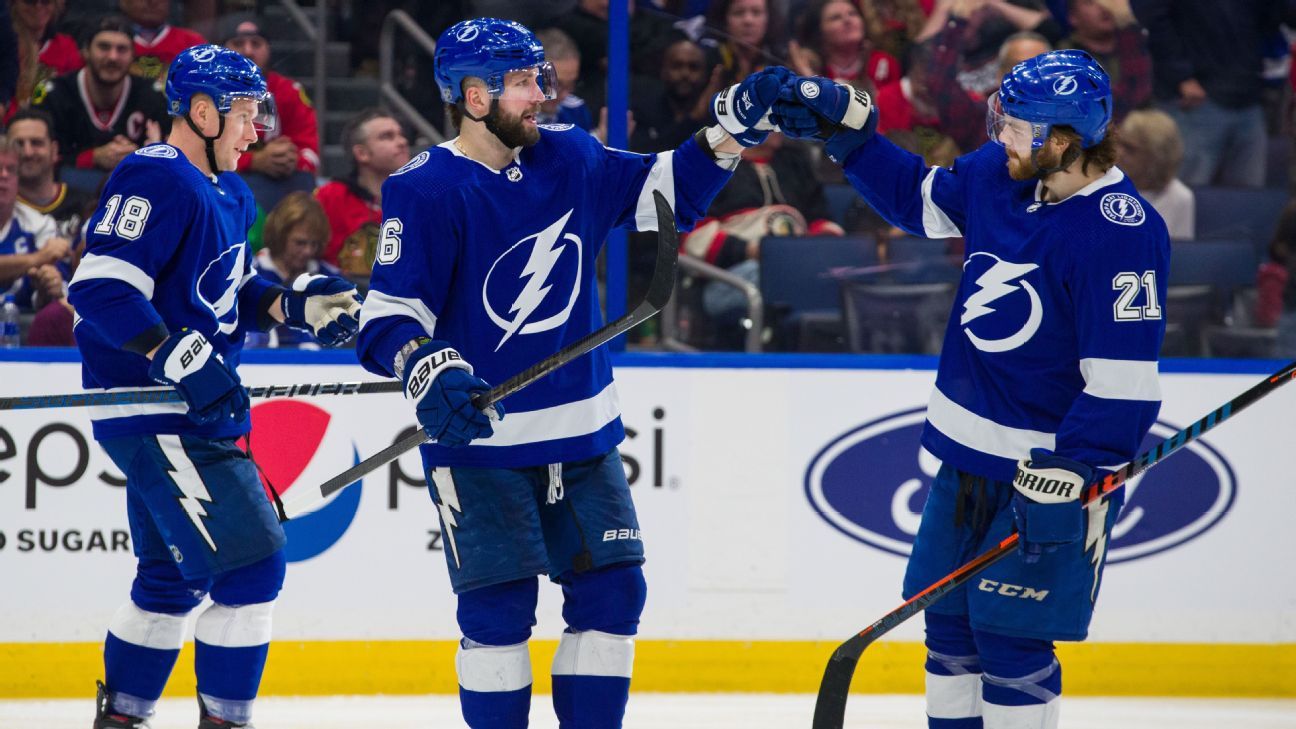The Tampa Bay Lightning are once again among the wagering favorites for the 2020 Stanley Cup. Which must be comforting, given they’re only a few months removed from critics wondering if coach Jon Cooper should be fired and whether their first-round sweep at the hands of the Columbus Blue Jackets last spring had irreparably damaged their collective psyche.
What the Lightning have done since that early stumble this season has reaffirmed them as contender for the championship that has eluded this group through three trips to the Eastern Conference finals and one loss in the Stanley Cup Final. Their stars were shining. Their much-discussed refocusing on defense was producing results. And that was before general manager Julien BriseBois aggressively anted up two first-round picks at the trade deadline for forwards Barclay Goodrow and Blake Coleman.
How did they turn their season around? How does this current roll compare to last season’s historic, regular-season juggernaut? And what does it all mean for their push for the Cup this postseason?
Note: Data in the story is from Natural Stat Trick, and as of the games of March 2, unless otherwise specified.
I. How did they flip the switch?
Two months into this season, the Lightning were anything but the Lightning. A loss at home to Carolina on Nov. 30 dropped them to sixth in their division, with a plus-9 goal differential and with their record at 12-9-3 on the season.
The previous season up to Nov. 30? They were 18-7-1, in first place and had a plus-23 goal differential.
Fast-forward to Dec. 23, 2019. The Lightning had been trending upward a bit, but from this 6-1 victory over the Florida Panthers onward, it was like the entire team snagged a power-up in a game of Mario Kart; the Lightning were suddenly lapping the field. The Lightning went 24-6-1 over their next 31 games, for a .790 points percentage, the best in the NHL during that stretch. They scored 112 goals and surrendered 73, the best goal differential in the league in that span.
They were the Lightning again.
So what changed?
Their offense rose from 3.47 goals per game in their first 34 games to 3.61 in their next 31 games. That’s not a mighty leap forward, but a significant uptick when you consider who was scoring those goals during the Lightning’s turnaround. Nikita Kucherov had 12 goals and a 1.12 points-per-game average in his first 33 games, and then he recaptured that Hart Trophy form: 19 goals in 30 games with a 1.43 points-per-game average. Steven Stamkos, currently injured, went from a points-per-game average of 0.96 in his first 31 games to 1.38 points per game in his next 26. Brayden Point went from a 0.84 points per game to 1.13 during the Lightning’s resurgence. And so on.
But it’s the defense that really turned things around for Tampa. That was an underrated hallmark of their incredible 2019-20 season: The Lightning were seventh in goals-against average (2.70). Their first 34 games this season didn’t look anything like that, with a 3.23 goals-against average; from Dec. 23 on, their goals-against average was a stellar 2.36.
Diving into the numbers, we discover that the Lightning’s 5-on-5 defense wasn’t that terrible during their early-season slump. They were seventh in expected goals against per 60 minutes (2.12) but were seeing different results, at 2.57 goals against per 60, which was 21st in the league. But when the switch was flipped … wow. The Lightning had an expected goals against per 60 minutes of 1.97, and a goals against of 1.95 per 60 minutes.
The two main catalysts for this defensive turnaround are somewhat intertwined. The first is their penalty kill, which went from 7.24 goals against per 60 minutes during the slow start down to 5.99 during their post-Dec. 23 roll.
The second is their 5-on-5 save percentage, which was .915 through the first 33 games of the season — one reason why the Lightning were giving up more goals than their play would expectedly yield — and jumped to .932 through the next 31 games.
This all tracks back to last season’s Vezina Trophy winner, Andrei Vasilevskiy. His first 25 games of the season yielded a .906 save percentage and a 2.88 goals-against average. In the next 23 games — during which he had an absurd 19-3-1 record — Vasilevskiy had a .923 save percentage and a 2.34 goals-against average.
(Backup Curtis McElhinney also got his act together after a sub-.900 start, with a .921 save percentage and a 2.13 goals-against average in nine games.)
The Lightning are best known for their offensive weaponry, and their star players certainly helped spark this dominant stretch. But when the switch flipped, it was their defense that powered it.
“Sometimes you just gotta play the simple game,” said Cooper after a Feb. 13 win against Edmonton. “Two [goals] or less, you’re giving yourself a chance to win the game. Three or more … you don’t want to be in a situation where you have to score your way out of games. You have to defend to win games. And I think that’s something our guys have attached themselves to and take pride in. It’s something we’ve been working on from training camp on. I know it wasn’t pretty early on, but you have to go through some growing pains. But it’s clicking now for us.”
II. How do they compare to last season?
It almost seems blasphemous to suggest that this season’s version of the Lightning is superior to the one that won 62 games, outscored their opponents by nearly 100 goals, and might as well have swept the individual awards last season. But this version of the Lightning objectively looks like the superior version, from the personnel they have available to the underlying performance indicators themselves.
The full-season numbers do them a disservice because of a variety of extenuating circumstances. Their schedule was thrown off by an early November trip to Europe, they were lagging behind in games played for a long period of time because of it, and they uncharacteristically couldn’t buy a save from Andrei Vasilevskiy.
There’s also something to the idea that they came out of the gate in a bit of malaise after last year’s abrupt finish, with everyone watching very closely to see whether they’d be able to regroup. Every single loss or underwhelming performance was microanalyzed for clues to suggest that something was fundamentally wrong. Put all of that together, and you get results that didn’t line up with expectations, or their talent level:
-
6-4-2 record, minus-1 goal differential in October
-
6-5-1 record, plus-9 goal differential in November
-
5-4-1 record, minus-1 goal differential to start December
Since that holiday break, it’s been an entirely different story. They’ve been on a complete rampage, not only beating opponents, but throttling them in trademark fashion:
They’ve had a recent stretch of uneven play, but that will happen over the course of an 82-game season. What’s most important for the Lightning is that the data is all there to suggest they’re as dominant as ever in the areas that count most. They’ve gone from (really) good to great at 5-on-5, establishing themselves as more of an even-strength juggernaut than they were while compiling all of those regular-season wins last season.
They’re sporting a 54.4% shot share, 56.6% high-danger chance share and 56.7% expected goal share. That’s significant for their future success, especially as they approach the postseason, where we know officiating patterns change and when the opportunities and ability to bank easy power-play goals dry up against better competition.
From a personnel perspective, there’s no argument against this version being better than last season’s, assuming full health, which is admittedly a big assumption right now considering that Steven Stamkos and Ryan McDonagh are both out for extended periods of time.
Losing J.T. Miller hurts, considering how much he has spread his wings in Vancouver this season, but he was seventh in 5-on-5 usage and ninth in total ice time among Lightning forwards last season, making him more of a luxury item than foundation piece. They’ve ostensibly replaced him, Anton Stralman (who isn’t what he once was), Dan Girardi (who is no longer playing in the league) and Ryan Callahan (whose body no longer allows him to play) with Kevin Shattenkirk, Blake Coleman, Patrick Maroon and Barclay Goodrow.
But the biggest development has been the internal improvement of their young players, with Anthony Cirelli and Mikhail Sergachev each taking gigantic leaps in their development. Cirelli has vaulted himself from being a nice, young, complementary player to a legitimate Selke Trophy contender with his play at both ends of the ice.
Having Cirelli able to jump up from playing 11:13 per game at 5-on-5 and 14:51 overall to 13:24 and 18:29, respectively, has opened doors for Jon Cooper. Not only has Cirelli handled the added responsibility and workload against the other team’s best players, but he has afforded the team the ability to load up its best offensive players as a three-headed, scoring monster without fear of what’ll happen when they’re not on the ice.
Similar to where we were with the Washington Capitals before they eventually got over the hump and won a title, we’ve reached a crossroads with the Lightning where no one really wants to hear about how good they’ve been in the regular season or what they’ve accomplished. But we are certainly witnessing one of the most impressive teams in recent history.
III. Have they changed/learned anything from their playoff failure?
It’s interesting looking back at the blueprint we laid out for how they could be beaten in a series last spring, because the Blue Jackets checked every single one of those boxes. They slowed the pace of the game, they were incredibly disciplined (giving the Lightning just 10 total power-play minutes in four games), they had good depth without any real weak links in the lineup and their goalie was at the top of his game.
That can be viewed as an oversimplification of where things went wrong last postseason, because no one at the time was predicting the way it would ultimately unfold, but it also serves as a cruel reminder of the unforgiving nature of the NHL playoffs. No matter what you accomplish over the course of 82 games and six months, all it takes is one bad week for your season to be over.
The most admirable thing Julien BriseBois and the Lightning have done is to avoid making reactionary moves, thinking with their heads instead of their hearts. The postseason can be about psychological warfare as much as physical, especially after the fact. We’ve seen plenty of strong teams make changes just for the sake of making changes after things went wrong, only to wind up regretting it. Allowing postseason failure to control your decision-making will push your team away from what made it special in the first place.
The Lightning haven’t really changed, and didn’t need to, because they were good at hockey and still are. Instead, they’ve tinkered on the margins, experimented with different combinations and added players to their supporting cast that can seamlessly mesh with their ethos as a team. If anything, they’ve doubled down on speed and skill, using those characteristics to grind their opponents down and change the way we think about what constitutes being “difficult to play against.”
That’s most evident in their penalty kill, which is now armed with relentless attackers who try to negate power plays by making them defend, as opposed to having penalty killers sit back in a shell, as is tradition. Playing against Anthony Cirelli and Blake Coleman when you’re up a man doesn’t look like it’s especially fun, with all of the time and space you would’ve relished disappearing. That type of aggression will be vital, considering Tampa Bay’s likely playoff road map this year, which includes the Maple Leafs and Bruins in the first two rounds, with either the Penguins or Capitals potentially waiting in the Eastern Conference finals.
We tend to think of the Lightning as an offensive team. This makes sense because they score a lot of goals and have a number of highly gifted stars. But they also give up the third-lowest rate of expected goals at 5-on-5, and sixth fewest overall. They also give up the fourth-lowest rate of high-danger chances at 5-on-5, and fifth-fewest across all situations, with nearly identical rates to a Bruins team that is widely considered to be one of the stingiest defensive clubs in the league. And Andrei Vasilevskiy’s struggles relative to the high standards he has set for himself are partially responsible for that.
His minus-13.2 goals saved above expected are nearly identical to Sergei Bobrovsky‘s minus-13.5 for the season, yet Vasilevsky hasn’t been scrutinized nearly as heavily because his .913 raw save percentage is decent, and he wins games playing behind a better team. There’s no goalie in the league more physically gifted, and it’s unlikely that Vasilevskiy suddenly forgot how to stop pucks at the age of 25, just one year removed from a Vezina Trophy. The sooner he starts playing his best, the better for a Lightning team that’s doing everything they can to make life easier for him. Beyond that, there’s no reason to believe the Lightning are not reliable enough defensively for playoff hockey, for the crowd that values that sort of thing as a benchmark for success this time of the season.
IV. So what does this mean for the playoffs?
Watching Cooper and his players attempt to rationalize their sweep at the hands of Columbus was excruciating. It was like trying to diagnose why a satellite fell to earth after a total systems failure.
“It’s tough to pinpoint one thing,” defenseman Ryan McDonagh said. “We hurt ourselves in a lot of different fashions. Strengths that were keys to us winning in the regular season didn’t get it done in this series. They won all of those categories.”
There are some things the Lightning can correct, and have addressed, before this postseason:
They have to earn more power-play chances than the six they were given in four games, converting once.
Adding Coleman and Goodrow will further bolster a penalty kill that was already in the top 10 this season, and that’s essential for the postseason. The Blue Jackets’ power play morphed into the mid-1970s Montreal Canadiens, whipping the puck around with constant motion. They finished 5-for-10 in the series. That obviously can’t happen again.
They can correct their discipline. Kucherov collected the Hart Trophy for league MVP two months after he missed Game 3 while serving a one-game suspension for boarding Jackets defenseman Markus Nutivaara. That’s inexcusable.
They can correct their offensive approach. It was obvious from the way the Lightning played that a team with an effective forechecking game could slow the offensive juggernaut to a crawl. That’s what happened. So the hope is that the Lightning learn to change up their offensive approach. Bringing in Maroon, the big rig who throws his body around behind the goal line in the postseason, addressed this. Goodrow and Coleman speak to this even more, given how the Bolts needed to bolster their bottom six.
But there’s something else the Lightning are going to have to fix, and it’s the thing that will make or break their Stanley Cup chances: their fortitude.
Cooper famously said after the Blue Jackets series that the Lightning didn’t know how to handle adversity because they never faced any during their historic regular season. “When you have the amount of points we had, it’s a blessing and a curse, in a way. You don’t play any meaningful hockey for a long time. Then, all of a sudden, you have to ramp it up. It’s not an excuse, it’s reality,” Cooper said after Game 4. “That’s how it goes: You have a historic regular season, and we had a historic playoff.”
Indeed it was, for all the wrong reasons. The Lightning lost Game 1 because they tried to win a 3-0 game by an 8-0 score, and their sloppiness cost them. Then, they were punched in the mouth with two goals in Game 2, failed to respond and the rest is NHL postseason history.
But the fortitude questions go beyond that. Key players from this current group won two Games 7 in 2015 before taking a 2-1 lead on the road in the Stanley Cup Final … and losing three straight to Chicago, including two one-goal games. The following season, they had a 3-2 lead over the Penguins in the Eastern Conference finals … and lost in seven games, getting outscored 7-3 in the final two. In the 2018 Eastern Conference finals, they again blew a 3-2 lead and were outscored by the Capitals 7-0 in their final two losses of the season.
Can this team be different?
“I just like the way the year has progressed and guys have gutted some things out,” Cooper said late last month, via the Athletic. “Mentally, we’re just a tougher team. When you’ve taken your lumps a few times, which way are you going to go? Are you going to succumb to the adversity or are you going to attack it? And that’s what we’ve been doing.”
Years from now, we’re either going to see the loss to the Blue Jackets last postseason as the vital education this group needed to become a champion, or the clearest indication there’s a systemic malfunction with this collection of players. And the only ones who can determine what we’ll see in that rearview mirror are the Lightning.


